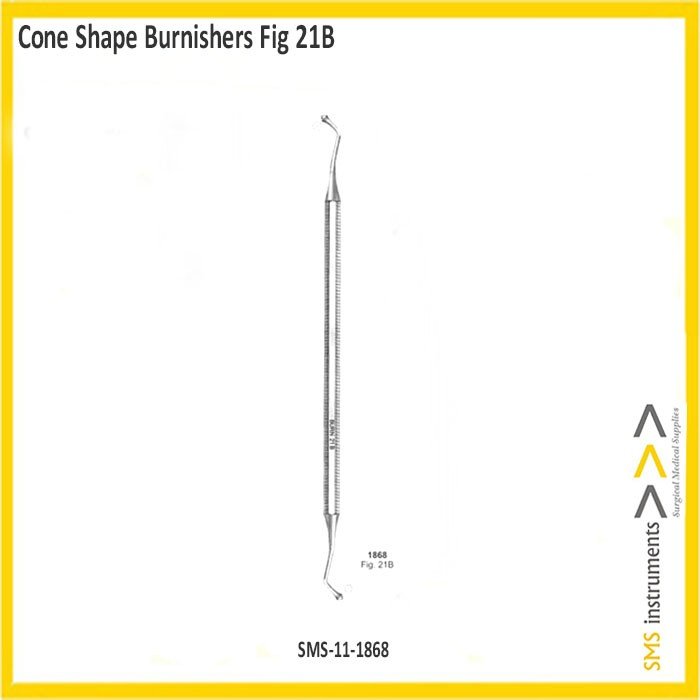Description
Cone Shape Burnishers Fig. 21B
Dental Instruments
SMS Burnisher Fig 21B Instrument used for composite placement and contouring.
| Surname | Burnishers |
| Tip Configuration | Pointed Ball |
| Size / Model / Figure | Fig 21B |
| curvature | Angled |
| Handle | Octagonal Double Ended |
| Finishing | Mirror Polish Finishing |
| Instrument Type | Dental Burnishers |
| Material | Stainless Steel |
| Disposable or Reusable | Reusable |
| Rusting Prevention | Passivation Processed |
| Cleaning | Ultrasonic Cleaned |
| Sterile or Non-Sterile | Non-Sterile |
| Latex or Latex-Free | Latex-Free |
| Test Performed | Boil, Shape & Performance Test |
| Grade | Premium OR-Grade |
| Packing | Individually Packed in SMS Brand printed Poly-sleeve
|
Burnisher
Burnishers are dental hand instruments and are normally used at the end of dental restoration procedures or operations. They are used to emphasize grooves and to shave off surplus fins. Burnishers are also used to smooth off the rough margins after a dental restoration, polish the dental restoration, and to remove any scratches formed on the amalgam surface formed during the dental procedure. The working ends of burnishers are angled and the ends, either or both, are rounded and smooth. The ends can be single-ended or double-ended in structure.
Nibs are spherical:
Ball shapes, Egg shaped, Apple shaped, Conical, Beaver Tail shaped, Hour Glass, Fish Tail, Bullet shaped etc.
The various types of burnishers based on the shape of their end parts are:
- Flat plastic burnisher
- Ball burnisher
- Beavertail burnisher
- Acorn burnisher
- T – Ball burnisher
- Foot Ball burnisher
- Rotary burnisher
Ball Burnisher
Function: To smooth amalgam after condensing to contour matrix band before amalgam placement. Commonly used are small ball burnisher.
Beavertail Burnisher
Function: To smooth amalgam after condensing; to burnish the lingual, facial amalgam walls of a restoration characteristics: similar shape to beaver tail, smooth, metal, single or double sided. Beavertail or egg shaped Condenser-narrow type of burnisher.
Acorn Burnisher
Function: To smooth amalgam after condensing; used to creat occlused anatomy, burnish amalgam Characteristics: Acorn shaped tip, metal, single or double sided.
T – Ball Burnisher
Function: To smooth amalgam after condensing to contour matrix band, initiate carving and occlused anatomy Characteristics: smooth metal has a ball and paddle single or double sided. The T – Ball burnisher has a T- shape at its one end, and one of the ends of the T-shape is shaped like a ball. The ball- end dental burnisher is usually used as a probe to find specific orodontal margins.
Foot Ball Burnisher
Function: To smooth amalgam after condensing to contour matrix band, to burnish amalgam Characteristics: smooth football shaped metal instrument, single or double sided.
Rotary Burnisher
Function: The rotary dental burnisher contains a shank portion that tapers down and connects to a fluted burnishing head. The rotary burnishing head are polished, rounded, and elongated and has ridges on the surface.
Burnisher are precision dental hand instruments and these delicate instruments need careful handling and maintenance to preserve their quality and promote longer life of the instrument. Dental burnishers are multipurpose precision hand instruments and are also used in the operative procedures of eye, ear, nose and throat.
The tooth burnisher can be divided into three parts:
The working ends, the shank, and the handle. The working end is at the very end of the tooth burnisher, and the shank will connect the working end to the handle.
The working ends of the burnishers are angled to allow the operator to reach the posterior tooth at the back of the mouth more easily. This is because the area at the back of the mouth, if the working ends are not angled, It is quite hard and impossible for the operator to each certain areas.









